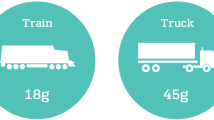Abstract
Due to changes in the industry which have led to opportunities for new market segmentations, revenue management (RM) methods have gained in importance for liner shipping companies in the recent past. Therefore, possible market segmentations of the liner shipping market and suitable RM methods are discussed in this work. Based on a slot allocation model for container bookings, three different booking acceptance strategies are studied and compared with respect to their applicability in liner shipping and their performance regarding profit and capacity utilization. Especially, a new bid-price (BP) strategy is developed and compared to previously presented booking limit strategies. A simulation approach is used to evaluate the strategies for different scenarios. The simulation study reveals large differences in the impact the strategies can have, e.g. depending on the booking forecast quality. As the new BP strategy shows very promising results for many different realistic scenarios, it can be highly recommended for application in liner shipping.




Similar content being viewed by others
References
Acciaro M (2011) Service differentiation in liner shipping: advance booking and express services. Int J Shipping Trans Log 3(4):365–383
Bertsimas D, Popescu I (2003) Revenue management in a dynamic network environment. Trans Sci 37:257–277
Bingzhou L (2008) A stochastic model for dynamic capacity allocation of container shipping two-dimensional revenue management. International conference on service systems and service management 2008:1–7
Brooks MR (2000) Sea change in liner shipping. Pergamon, Oxford
Brooks MR, Button KJ (1994) Yield management: A phenomenon of the 1980s and 1990s? Int J Trans Econ 21(2):177–196
Brouer BD, Pisinger D, Spoorendonk S (2011) Liner shipping cargo allocation with repositioning of empty containers. INFOR Inf Syst Operat Res 49(2):109–124
Demirag O, Swann J (2007) Capacity allocation to sales agents in a decentralized logistics network. Naval Res Log (NRL) 54(7):796–810
European Commission (2006) Council regulation (ec) no 1419/2006 of 25 September 2006. http://eur-lex.europa.eu/LexUriServ/LexUriServ.do?uri=OJ:L:2006:269:0001:01:EN: HTML, Accessed 5 Aug 2013
Feng CM, Chang CH (2008) Optimal slot allocation in intra-asia service for liner shipping companies. Marit Econ Log 10:295–309
Feng CM, Chang CH (2009) Optimal slot allocation with empty container reposition problem for asia ocean carriers. Int J Ship Trans Log 2(1):22–43
Hanke J, Wichern D (2009) Business forecasting. Pearson/Prentice Hall, New Jersey
Hapag Lloyd (2013) Services from North Europe to Asia. http://www.hapag-lloyd.com/en/products_and_services/services_between_north_europe_and_asia.html, Accessed 5 Aug 2013
Hellermann R (2006) Capacity options for revenue management: theory and applications in the air cargo industry. Springer, Berlin
Leach PT (2011) Maersk to charge fees for no-show containers. http://www.joc.com/maritime-news/international-freight-shipping/maersk-charge-fees-no-show-containers_20110623.html, Accessed 5 Aug 2013
Lee LH, Chew EP, Sim MS (2007) A heuristic to solve a sea cargo revenue management problem. OR Spectrum 29(1):123–136
Lee LH, Chew EP, Sim MS (2009) A revenue management model for sea cargo. Int J Operat Res 6:195–222
Lu HA, Chu CW, Che PY (2010) Seasonal slot allocation planning for a container liner shipping service. J Mar Sci Technology 18(1):84–92
Maersk Line (2010) Its in your hands. Weekly highlights January 26th
Maersk Line (2011a) Daily maersk—press kit. http://www.dailymaersk.com/html/pdf/PressKit_A4_2.pdf, Accessed 5 Aug 2013
Maersk Line (2011b) The new normal—a manifesto for changing the way we think about shipping
Maragos S (1994) Yield management for maritime industry. PhD thesis, Massachusetts Institute of Technology
Salisbury M (2011) The JOC top 50 world container ports. J Commerce 12:32–38
Simpson RW (1989) Using network flow techniques to find shadow prices for market and seat inventory control. Flight transportation laboratory memorandum M89–1. MIT, Cambridge
Talluri KT, van Ryzin G (1998) An analysis of bid-price controls for network revenue management. Manag Sci 44(11):1577–1593
Talluri KT, van Ryzin GJ (2004) The theory and practice of revenue management. Springer, New York
Ting SC, Tzeng GH (2004) An optimal containership slot allocation for liner shipping revenue management. Marit Policy Manag 31(3):199–211
UNCTAD (2008) Review of maritime transport 2008. Tech. rep., United Nations Conference in Trade and Development.
Williamson EL (1992) Airline network seat control. PhD thesis, MIT, Cambridge
Xiangzhi B, Rongqiu C, Li L (2007) Container slot allocation model with liner shipping revenue management. In: Proceedings of ICM 2007 The 6th international conference on management, pp. 130–137
Zou H, Ding J (2008) Analysis of capacity allocation for sea cargo based on revenue management. In: International conference on service operations and logistics, and informatics 2008, vol 1, pp 1399–1402
Zurheide S, Fischer K (2011) A simulation study for evaluating a slot allocation for a liner shipping network. In: Böse JW, Hu H, Jahn C, Shi X, Stahlbock R, Voß S (eds) Proceedings of the 2nd international conference on computational logistics, LNCS 6971. Springer, Berlin, pp 354–369
Zurheide S, Fischer K (2012a) A nested booking limit algorithm for liner shipping slot allocation. In: Applied mathematical optimization and modelling (APMOD 2012), pp 334–338
Zurheide S, Fischer K (2012b) A revenue management slot allocation model for liner shipping networks. Marit Econ Log 14(3):334–361
Acknowledgments
The authors would like to thank the editors and two anonymous referees for their helpful comments on a first version of this paper
Author information
Authors and Affiliations
Corresponding author
Rights and permissions
About this article
Cite this article
Zurheide, S., Fischer, K. Revenue management methods for the liner shipping industry. Flex Serv Manuf J 27, 200–223 (2015). https://doi.org/10.1007/s10696-014-9192-0
Published:
Issue Date:
DOI: https://doi.org/10.1007/s10696-014-9192-0




